- Development and application of high-performance compound salt drilling fluid
Jian Wanga, Hanxuan Songb,*, Jian Guana and Hongyu Liua
aGWDC Drilling Engineering and Technology Research Institute
bChina University of Petroleum, Beijing, ChinaThis article is an open access article distributed under the terms of the Creative Commons Attribution Non-Commercial License (http://creativecommons.org/licenses/by-nc/4.0) which permits unrestricted non-commercial use, distribution, and reproduction in any medium, provided the original work is properly cited.
Due to the characteristics of deep burial, abnormal pressure, high bottom hole temperature, and abundant fractures, the tight oil reservoirs in the Leijia block of Liaohe Oilfield have many complex situations such as lost circulation and electrical resistance encountered, which seriously restricts the development of tight oil and gas resources in Leijia. Safe and efficient development. To solve this problem, firstly, the mechanism of the wellbore instability of the tight mud shale in the Leijia block was studied. Then, the formula of the composite salt base fluid was optimized by using the principle of activity balance, and the nano-plugging with core-shell structure was developed in a targeted manner. Finally, a high-performance drilling fluid system with strong plugging, strong inhibition and strong lubrication was constructed. The temperature resistance of the system reaches 150 °C, the primary recovery rate of shale is 97.8%, the permeability is reduced by more than 50%, and HTHP (150 °C) is less than or equal to 8 mL. In the test of Well L77-HX in Leijia block, the accident complexity rate is 0, the success rate of electrical measurement is 100%, the ROP is increased by 40%, the drilling depth is 5000m, and the horizontal displacement is 1783m. This new compound salt high-performance drilling fluid system provides technical support
Keywords: Hole collapse, New compound salt drilling fluid, Activity balance
The tight oil reservoir in the Leijia block of Liaohe Oilfield is recognized as one of the blocks with the highest rate of complex accidents and the most difficult to develop in the Liaohe Oilfield [1]. From top to bottom, the strata are Minghuazhen Formation, Guantao Formation, Dongying Formationan and Shahejie Formation 1, 2, 3, 4. The target layer is Shahejie Formation 4. Lime mudstone, carbonaceous mudstone, argillaceous dolomite, and dolomitic shale are widely developed in the third and fourth members of Shahejie Formation [2-4]. The vertical depth reaches 4000 m, the formation pressure coefficient reaches 1.5, the bottom hole temperature reaches 150 ℃, and the cracks are relatively large [5, 6]. and development is big difficult because acid gas exists in the formation. Higher requirements are put forward for drilling fluid temperature resistance, acid radical pollution resistance, inhibition performance, and plugging performance. Since 2010, drilling companies have mainly adopted polysulfonated silicone anti-collapse drilling fluid system and KCl polymer drilling fluid system for construction [7, 8]. Although the silicone system meets downhole needs in terms of temperature resistance and wellbore purification, its inhibitory properties are The resistance to HCO3- is lower than that of the KCL polymer system. After adding the silicone viscosity reducer, the soil powder and the hydrated rock cuttings are finely dispersed, the rheology is not easy to control at high temperature and high density, the solid content of the mud is high, and the directional support pressure is problematic [9, 10]. The KCl-polymer system has good inhibitory properties. It has the characteristics of inhibiting the hydration and dispersion of clay and strong stability in the application of gray-green mudstone in the second member of the Shahejie Formation. However, the plugging performance of the system needs to be improved. Problems such as lost circulation and brittle mudstone well collapse often occur in the application of the fourth section. According to statistics, the two drilling fluid systems in the third and fourth members of the Shahejie Formation in Leijia block frequently have complex conditions and accidents such as wellbore instability, leakage, electrical test resistance, and casing failure [11-15]. They have been developed. The rate of complex accidents in horizontal wells is as high as 80%. In directional wells, there are often complicated situations such as lost circulation, large-scale demarcation of the skew section, and blockage during tripping, which severely restrict the safe and efficient development of Leijia's tight oil and gas resources [16, 17].
In order to ensure the efficient development of Leijia tight oil and gas resources, based on the research and analysis of the instability mechanism of the tight mud shale borehole wall in Leijia block, this article has carried out targeted treatment agent development, and optimized and compounded the core treatment agent. A high-performance drilling fluid system with strong plugging [18], strong inhibition and strong lubrication was constructed and applied on site.
Quantitative detection of whole rock and relative content analysis of clay minerals
Taking the core of Lei-X well in Leijia block as an example, an X-ray diffractometer was used for quantitative detection of whole rock and relative amount detection of clay minerals. The main results are shown in Table 1 and Table 2. X-ray diffraction analysis results show that the mudstone mineral composition of the fourth member of Shahejie Formation in Leijia block is very different. The minerals are mainly quartz sand and clay minerals, and clay minerals account for 35.4%; non-clay minerals are plagioclase, quartz, and calcite. The content of brittle minerals is 63.8%, indicating that it is extremely brittle and belongs to hard and brittle shale. The analysis results of clay mineral content show that its main component is the Imonite mixed layer, with a content of 69%, accounting for 27.1% of the total rock content; a small amount of illite, chlorite and kaolin are developed. The existence of a large number of Imonite mixed layers is extremely unfavorable to the stability of the well wall. After the montmorillonite layer, which is easy to absorb water and swells, absorbs water, the interlayer hydration repulsive force increases, resulting in uneven pressure distribution of the Imonite mixed layer, interlayer displacement and expansion, resulting in wells Wall instability.
SEM analysis of field emission environment
The field emission scanning electron microscope has ultra-high resolution, and has comprehensive analysis capabilities for topography and chemical composition. You can visually observe the pores and fine cracks on the mudstone surface. A field emission scanning electron microscope was used to analyze the core of the target block. The scanning electron microscope picture is shown in Fig. 1.
It can be seen from the results of field emission scanning electron microscopy that, when observed at a magnification of 400, the core particles are tightly arranged, and some of the particles are inlaid. When local magnification is 1600 times, there are micro-cracks and honeycomb-shaped pores, and the micro-cracks have the characteristics of long extension length and large degree of bending. When magnified to 3000 times, it shows the dissolution of detrital minerals and partial claying. The intergranular pores of clay minerals are relatively developed, with micro-cracks, and the widths of the fractures vary, mainly distributed in 2 to 3 μm. At 6000 times, it was observed that the leaf-shaped chlorite cushioned cement particles distributed on the grain surface had different widths of microcracks, mainly distributed in 830-890 nm, and the microcracks had a long extension length. Partial dissolution of cuttings can be seen at a multiple of 12000, like clay minerals are transformed obviously, and the pores between clay minerals are relatively developed. Shale shaft wall instability is closely related to the characteristics of micro-pore development, and the development of shale micro-cracks is the internal cause of shaft wall instability.
Mechanism analysis of shaft wall instability in Leijia block
Internal cause: Combining the results of whole-rock quantitative experiment and scanning electron microscope experiment, it is concluded that the mudstone mineral composition of the fourth member of Leijiasha Member in Liaohe Oilfield is very different, and the brittle mineral is 63.8%, indicating that the rock is brittle and has obvious characteristics of hard brittleness. The content of clay minerals is 35.4%, and the mixed layer of Imonite accounts for 69%. Because of the high content of Imon mixed layer, the strong inter-layer ionic bond is less than that of montmorillonite. The non-swelling and swelling clays are interphased. Among them, the hydration capacity of montmorillonite is Strong, illite is relatively weak. When the drilling fluid filtrate enters the formation along the pores and cracks, it causes non-uniform expansion, which further weakens the structural strength of the shale and makes the formation rock more prone to brittle fracture, downhole collapse and block loss. This lithological component determines that the formation is not easy to disperse, and the slurry-making performance is not strong, but it is easy to swell and cause spalling.
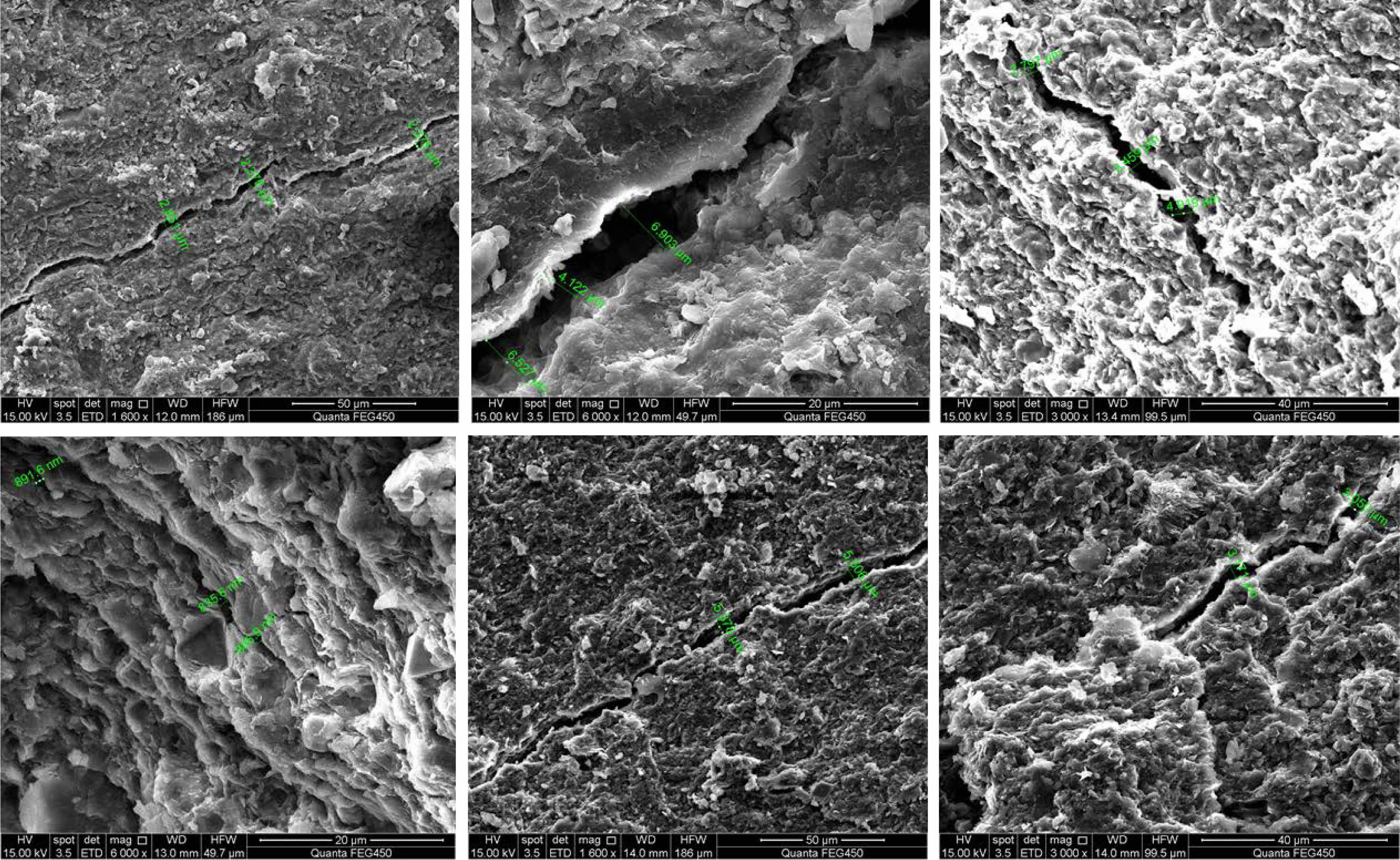
|
Fig. 1 SEM of Lei-X well core. |
Compound salt system
Research on basic fluids satisfying activity balance
Based on the analysis of the wellbore instability mechanism in the Leijia block, reduce the chemical potential energy and keep the drilling fluid activity lower than the formation water activity to reduce the water content and pore pressure in the near-wellbore zone. When the drilling fluid activity is lower than the formation water activity, the smaller the ratio of the drilling fluid activity to the formation water activity, the more conducive to the stability of the borehole wall. Because shale has low permeability, it can partially prevent ions from passing through and act as a semi-permeable membrane. In this way, the semi-permeable membrane effect can be balanced by adjusting the water phase activity of the drilling fluid, and the chemical osmotic pressure can offset part of the hydraulic pressure difference. The filtrate intrusion and pressure transmission caused to promote the stability of the well wall [19].
The HD-3A type intelligent water activity measuring instrument was used to test the water activity of the core and mudstone falling off the well. The data are shown in Table 3. The data shows that the water activity of the core of the fourth member of Shahejie Formation in Leijia block is between 0.636 and 0.654. As the well depth increases, the activity tends to decrease. Combined with a large amount of experimental data and comprehensive cost considerations, the formulation of the composite salt base fluid is: 5% KCl + 10% sodium formate + 8% potassium formate, which can realize the compatibility of the liquid phase water activity of the drilling fluid with the formation, improve the membrane effect, and achieve The effect of well wall stabilization. While achieving inhibitory properties, the composite salt has a good compatibility with the polymer treatment agent, and also has the effect of improving the thermal stability of the polymer treatment agent.
Development of high-efficiency plugging agent
The results of scanning electron microscopy experiments show that micro-cracks in the fourth member of Leijiasha Formation are developed, with a crack width ranging from 800 to 1200 nm. However, the currently used plugging agent on site is asphalt and ultrafine calcium carbonate, which cannot effectively seal nano-micron micro-cracks. Blocking. Adopt nano-silica, use ultrasonic dispersion and silane coupling agent to modify it, and stir for 2 h under the condition of a temperature of 80 °C. and weak alkaline to obtain modified nano-silica. Take a certain amount of modified nano-silica and add 3% dispersant A to prepare nano-micron plugging agent GW-NBF. The particle size analysis data is shown in Fig. 2, and the TEM of the particles in the dispersed state is shown in Fig. 3. And the particle size forms a multi-peak value, which can meet the 800-1200 nm particle size requirements, and bridges and plugs in the pores, following the "1/2" and "2/3" bridging rules.
Optimization of organic amine inhibitors
In recent years, strong organic amine inhibitors have been intensively studied for the problems of complex well collapse, mud packs, and blocking resistance. When the pH value is lower than 9.5, the organic amine compound will be protonated or partially protonated, and gradually dispersed in water. The cationic group amine group preferentially adsorbs to the surface of the clay, and it can inhibit the hydration swelling and dispersion of the clay through electric neutralization. After being embedded between the clay layers, it can compress the thickness of the diffusion electric double layer on the surface of the clay, reduce the adsorption of water molecules, and show excellent inhibition performance. It has become an essential treatment agent in high-performance drilling fluid systems [20]. Table 4
Three organic amine inhibitors are selected, and mudstone cuttings of the fourth member of Shahejie Formation in Leijia block are selected, and two methods of shale rolling recovery experiment and clay swelling experiment are used to evaluate their ability to inhibit mudstone. The experimental data are shown in Table 5. The results show that 3# has the strongest inhibitory effect, but foaming is serious after its addition. 2# also has a higher recovery rate of shale and a lower linear expansion rate, and 2# is preferred as a system inhibitor.
Optimization of salt-resistant extreme pressure lubricants
If the drilling tool rotates slowly in an ideal vertical well with large annulus clearance, the drilling tool and the surface of the well wall are completely isolated by the drilling fluid, and the frictional resistance is only related to the viscosity and lubrication performance of the drilling fluid. This friction is fluid friction. Or fluid lubrication, improving the lubrication performance of drilling fluid can reduce frictional resistance. In the drilling of a long horizontal section horizontal well, due to the bending of the wellbore and the long horizontal section, the contact area between the drill string and the well wall is large, dry friction occurs or boundary friction occurs when separated by the interface film. At this time, only the lubrication performance of the drilling fluid is improved. If the coefficient of friction cannot be reduced, an extreme pressure lubricant with a strong interface film must be selected, as well as salt and temperature resistance. At present, the lubricant used for drilling fluids in Liaohe Oilfield is motor oil, and the average amount added in horizontal wells is 6%-8%. During the drilling of the skew section and the long horizontal section, back pressure and tool surface instability often occur. Through a large amount of literature and data research, two high-efficiency extreme pressure lubricants are selected for comparison experiments with the current lubricants, and the base slurry is added at a 3% addition. The formula is: 1% soil + 0.3% caustic soda +5%KCl+10% sodium formate+8% potassium formate +0.2%XCD, using EP extreme pressure lubrication meter and high temperature and high pressure adhesion meter (GNF) type for evaluation, the experimental results are shown in Table 5.
The experimental data show that 2# and 3# lubricants have good temperature resistance and lubrication effect, and have good compatibility with the system. The 2# lubrication coefficient reduction rate and adhesion coefficient reduction rate are the highest. It is composed of vegetable oils, alcohols and a variety of special surfactants, which can form a firm adsorption film on the surface of drill bits, drill tools and other tools, which can greatly reduce the wear and fatigue of the drill tools during the drilling process, and prevent The sticking accident of downhole drilling tool occurs, and it has defoaming effect on the drilling fluid after being added, which can replace the defoaming agent.
Optimal compatibility of functional treatment agents
The current treatment agents commonly used in drilling in Liaohe Oilfield are optimized, and the effects of FA367, PAC-LV, SPNH, superfine calcium carbonate, and KFT on the rheology and stability of the system are analyzed. Orthogonal experiments are designed, it is preliminarily clear that several treatment agents affect the system. See Table 6.
Orthogonal experiment results show that adding FA-367 has a certain effect on the rheological properties of the system, and its coating effect is not compatible with the system. When the added amount is less than 0.3%, the effect on the rheological properties of the system is small, and the added amount exceeds 0.5% At this time, the viscosity and shear force of the system increased significantly, and the phenomenon of wire-drawing and climbing rods appeared at the same time. When the addition of KFT exceeds 0.6%, the viscosity and shear force of the system will decrease; when the addition is less than 0.3%, the viscosity and shear force of the system can be reduced slightly, and it can be used as a flow regulator. The addition of SPNH and superfine calcium only reduces fluid loss, has little effect on the rheology of the system, and has good compatibility with the system. The fluid loss agent PAC-LV has little effect on the rheology of the system. After adding 0.7%, the plastic viscosity of the system will increase slightly, which has a certain fluid loss reduction effect.
Indoor evaluation of new drilling fluid performance
Through basic fluid research, development of high-efficiency plugging agent, optimization of main treatment agents, compatibility with functional treatment agents such as salt-resistant fluid loss reducers, flow pattern regulators, etc., a high-performance drilling fluid formula is obtained based on a large number of experimental results: 1% Soil+0.3% caustic soda+5%KCl+10% sodium formate+8% potassium formate+0.4% viscosity-increasing and cutting agent+2% anti-salt and anti-temperature fluid loss agent+1%PAC-LV+0.3%organic amine+2-3% nano-micron plugging agent + 2% ultra-fine calcium carbonate + 3% extreme pressure lubricant + weighting agent.
Evaluation of temperature resistance
The drilling fluid performance of the system was evaluated at 80 °C, 100 °C, 120 °C, and 150 °C. The results are shown in Table 7.
The experimental data show that with the increase of temperature, the plastic viscosity and dynamic shear force of the system change less, showing strong stability. This is because formate ionizes acid radical ions with reducing properties, can consume oxygen in the system, has a certain degree of oxidation resistance, and improves the thermal stability of treatment agents such as polymers. After aging at 150 °C for 16 hours, the dynamic shear force and static shear force have a downward trend, but the decline is not high, and it can also meet the requirements of horizontal wellbore cleaning and cuttings carrying. The medium pressure and high temperature and high pressure fluid loss are small, indicating that the The set system can resist high temperature of 150 ℃, which can meet the requirements of the temperature resistance of drilling fluid in Leijia area.
Evaluation of anti-pollution performance
The anti-pollution ability of drilling fluid refers to its ability to resist calcium, resist bad soil, and resist acid radical pollution. The formation of the third member of Shahejie Formation in Leijia block contains acid gas pollution; the drilling fluid is polluted during the drilling process and the fluidity becomes poor. The viscosity of the drilling fluid does not change much after adding inferior soil (mainly mudstone and cuttings in the formation), which indicates that the drilling fluid has strong inhibition and can prevent the dispersion of the external inferior solid phase in the drilling fluid.
To evaluate the ability of composite salt high-performance water-based drilling fluid to resist inferior soil, add 10% of inferior soil (passed through 80 mesh sieve) and age at 150 °C for 16 hours. The measured performance is shown in Table 8.
The experimental results show that after adding 10% of inferior soil, the apparent viscosity, plastic viscosity, and dynamic shear of the composite salt high-performance water-based drilling fluid does not change much, indicating that it has a strong ability to resist the pollution of inferior soil, and also proves the The system has a synergistic effect through organic amines and composite salts, which makes the system extremely inhibitive.
Add sodium bicarbonate to the formula to simulate bicarbonate pollution. The data are shown in Table 9. The results showed that the rheological properties of the system did not change significantly after 0.5% NaHCO3 was added to the system, and the influence of fluid loss was small, indicating that the system had strong resistance to HCO3- pollution.
Lubricity evaluation
The lubrication performance of the composite salt high-performance water-based drilling fluid, KCl-polymer drilling fluid, organic silicon anti-collapse drilling fluid and oil-based drilling fluid were evaluated using a slider friction tester. The data is shown in Fig. 3.
The experimental results show that the composite salt high-performance water-based drilling fluid has a lubrication coefficient of 0.11, which is higher than the KCl-polymer drilling fluid and organosilicon anti-collapse drilling fluid system, and is only 0.03 lower than that of the oil-based drilling fluid, showing extremely strong Lubrication performance.
Evaluation of inhibition
The cuttings rolling experiment and linear expansion experiment were used to evaluate the inhibition performance of composite salt high-performance water-based drilling fluid, KCl-polymer drilling fluid and oil-based drilling fluid.
Cuttings rolling recovery experiment
Take a rock sample of the target layer of Leijia tight oil block, dry it and crush it to 6-10 mesh, roll it at 150 ℃ for 16 hours, recover the rock sample with a 40-mesh sieve, and put the recovered rock sample in a watch glass. Bake in an oven at 105 ℃±3 ℃ for 6 h; weigh.
The results show as Fig. 4 that the primary cuttings recovery rate of the composite salt high-performance drilling fluid is 95.52%, which is close to the oil-based drilling fluid, which reflects that the system adheres to the cuttings surface through the synergistic effect of small molecular organic amines and composite salts and compresses inside. The electric double layer reduces the distance between the clay layers in the cuttings, and also limits the water absorption and expansion, and also has the K+ mosaic effect to further stabilize the cuttings.
Clay linear expansion experiment
The cuttings recovery experiment shows that the system has strong inhibition. In order to further evaluate its ability to inhibit clay, the benchmark bentonite was used to carry out the clay linear expansion experiment.
The results show that the inhibitory effect of composite salt high-performance water-based drilling fluid on clay is second only to that of oil-based drilling fluid, and it has extremely strong clay inhibitory ability.
Evaluation of plugging properties of high-performance drilling fluids
A nano sand table with a simulated crack width of 1 μm is used to prepare drilling fluid indoors. Carry out block rock sample plugging evaluation experiment, record the cumulative liquid output at different time points, and the curve is shown in Fig. 5.
After the plugging agent is added, the fluid loss of the drilling fluid is low, indicating that the plugging agent developed has a good plugging effect on nano-micro pores and fractures.
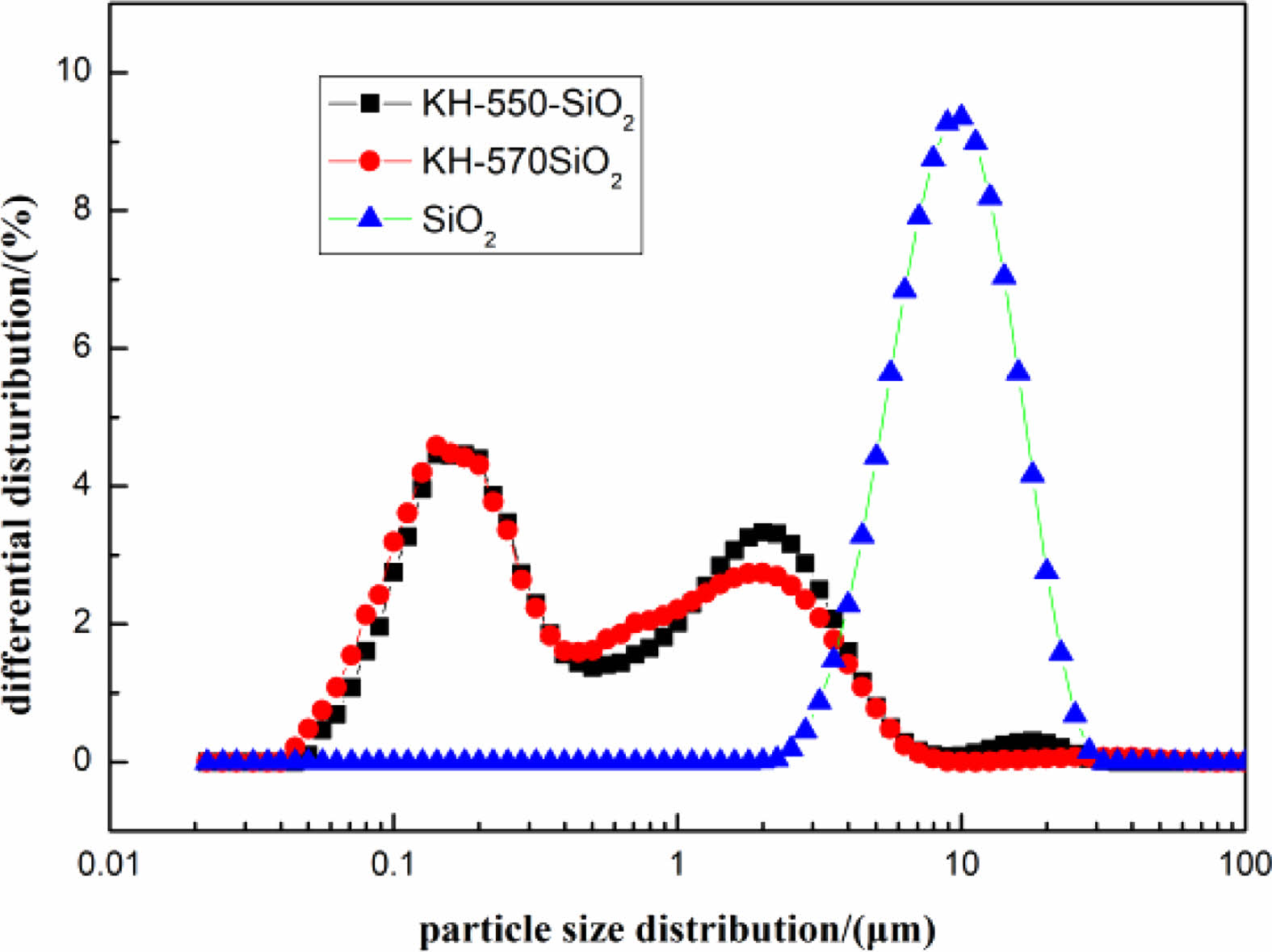
|
Fig. 2 Particle size distribution |
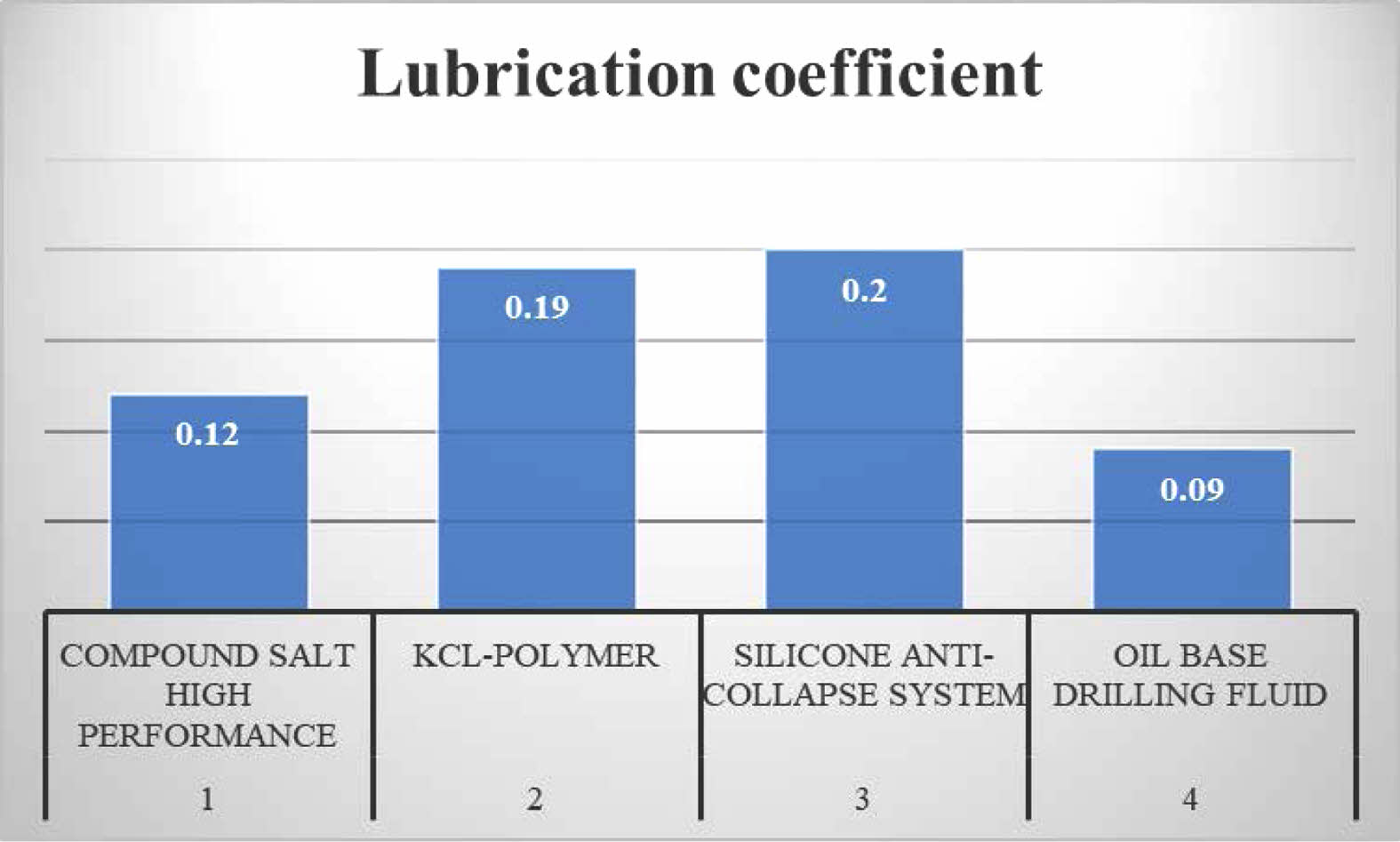
|
Fig. 3 Lubrication coefficient. |

|
Fig. 4 Rolling recovery |
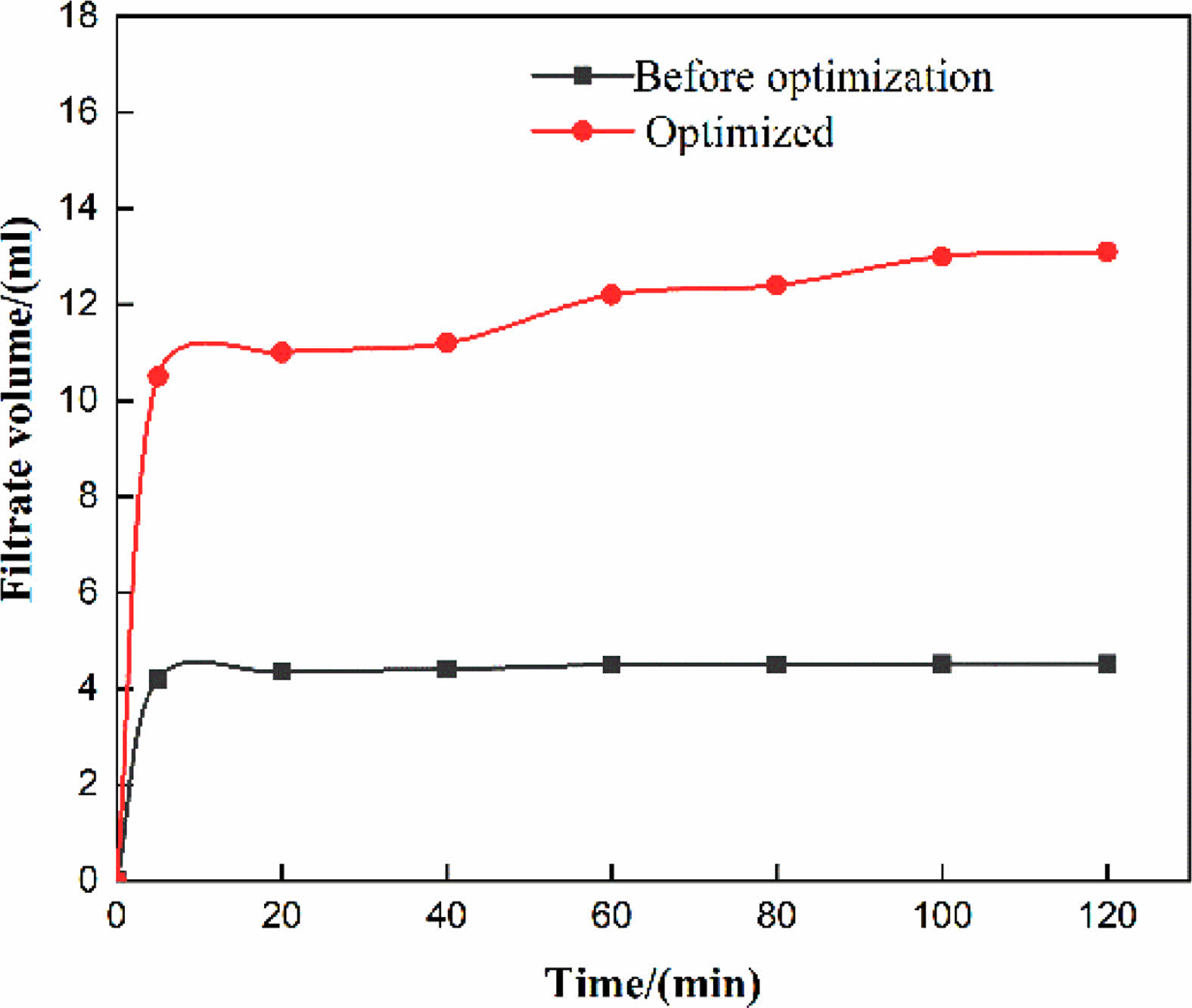
|
Fig. 5 Evaluation of plugging effect. |
The composite salt high-performance drilling fluid technology was applied on-site in the L-77-HX well in the Leijia block. There were no complications or accidents during the application process. The drilling depth was 5000 m and the horizontal displacement was 1783 m. The construction of the well was completed with high quality and high efficiency, and for the first time, zero accidents and zero complex operations of horizontal well blocks in this area were realized. Created four records of the fastest, deepest horizontal well, the longest horizontal section, and the largest horizontal displacement in Leijia block.
Well L-12X used the KCl polymer fluid system for construction, and many vicious and complicated accidents such as well wall collapse, sticking, and well filling occurred.
Application effect comparison
Judging from the on-site application effects of the two wells using different systems, the use of the high-performance system did not cause wall instability and large-area collapse, and the construction was smooth and efficient, and the speed increased significantly. See Table 10.
(1) By analyzing the physical and chemical properties and formation characteristics of shale in the Leijia block, it is concluded that the mechanism of wellbore instability is that the formation core contains a large number of micro-nano pores, and when the drilling fluid filtrate enters the formation along the pores and fractures, fractures are caused. Development and heterogeneous expansion of clay minerals.
(2) In view of the development of micro-nano pores in this block, a plugging agent matching the formation pores and fractures has been developed in a targeted manner. The D50 particle size is about 300-400 nm, and the activity balance theory is used to optimize the amine-based inhibitor and polarizer. A set of high-performance drilling fluid system has been established. The system has a rolling recovery rate of more than 93%, and the three rolling recovery rate is close to 80%. The 8 h linear expansion rate is only 10.83%, the cumulative fluid loss in fractured shale density rocks is reduced by 59%, and the permeability is reduced by more than 50%. With strong inhibition and strong blocking
(3) The new compound salt high-performance drilling fluid has been applied on site in Well Lei 77H7, which has a remarkable anti-slump effect and can solve the problem of wellbore instability in the hard and brittle mud shale in the Leijia block. It is confirmed that the drilling fluid has a wide application prospect.
Major special projects of joint-stock companies-Research and application of key technologies for stable production of 10 million tons in Liaohe Oilfield "Research and Application of Key Technologies for Drilling and Production Engineering" (2017E-1605).
- 1. M. Duan, C.C. Li, XD Wang, SW Fang, Y Xiong, and P Shi, J. Petrol. Sci. Eng. 172[0920-4105] (2019) 1112-1119.
-

- 2. F.G. Friaça, M.S and Pereira, and C.H. Ataíde, Chem. Eng. Sci. 275[0009-2509] (2023) 118752.
-

- 3. S.E. Hosseini, I. Nowrouzi, K. Shahbazi, M. Kamari, A.H. Mohammadi, and A.K. Manshad, J. Petrol. Sci. Eng. 223[2949-8910] (2023) 211465.
-

- 4. H Zhong, X. Gao, Z. Qiu, B. Sun, W. Huang, and J. Li. Carb, Poly. 249[3] (2020) 116833.
-

- 5. H. Jinhua and Z. Xing, J. Mol. Liq. 391[0167-7322] (2023) 123317.
-

- 6. O. Oni, A.S. Fadairo, W. Gosnold, S. Egenhoff, G. Adeyemi, and K. Ling, Pow. Tech. 430[0032-5910] (2023) 118972.
-

- 7. B. Misbah, A. Sedaghat, S. Balhasan, R. Elgaddafi, M.A. Malayer, R.N. Malhas. M. Omar, and M. Benomran, J. Petrol. Sci. Eng. 230[2949-8910] (2023) 212235.
-

- 8. S.Davoodi, M. Al-Shargabi, D.A. Wood, V.S. Rukavishnikov, and K.M. Minaev, Petr. Sci. [1995-8226] (2023) 131701.
-

- 9. Y. Luo, L. Lin, P.Y. Luo, Y.J. Guo, M.R. Wang, S.X. Xie, G.X. Xiong, and H. Gu, Coll. Surf. A. 672 (2023) 131701.
-

- 10. P.C.F. da Câmara, L.Y.C. Madruga, N.d.N. Marques, and R.C. Balaban, J Mol. Liq.327 (2021) 114808.
-

- 11. K.H. Lv, J. Liu, J. Jin, J.F. Jin, J.S. Sun, X.B. Huang, J.P. Liu, X. Guo, Q.L. Hou, J.W. Zhao, K.S. Liu, J.T. Wang, and Y.R. Bai, Coll. Surf. A. 637[0227-7757] (2022) 128274.
-

- 12. J. Liu, T. Ma, J. Fu, et al. Fully coupled two-phase hydro-mechanical model for wellbore stability analysis in tight gas formations considering the variation of rock mechanical parameters. J. Nat. Gas. Sci. Eng. 115[0167-7322] (2023) 205023.
-

- 13. M. Yu, M.E. Chenevert, and M.M. Sharma, J. Petrol. Sci. Eng. 38[3] (2003)131-143.
-

- 14. S.B. Aghdam, A. Moslemizadeh, E. Kowsari, and N. Asghari, J. Nat. Gas. Sci. Eng. 83[38] (2020) 103576.
-

- 15. R.I. Nwonodi, E.E. Okoro, and A. Dosunmu, J. Petrol. Sci. Eng. 228[2949-8910] (2023) 212019.
-

- 16. S.Davoodi, M. Al-Shargabi, D.A. Wood, and V.S. Rukavishnikov, Fuel. 357[0016-2361] (2024) 129692.
-

- 17. Z.H. Shao, J.T. Wang, M.M. Zhou, E.C. Wang, K.H. Lv, Z.L. Wang, X.B. Huang, R. Wang, C. Lu, and J.S. Sun, J. Nat. Gas. Sci. Eng. 104[1857-5100] (2022) 104619.
-

- 18. Z. Zhao, J.S. Sun, F. Liu, R.C. Cheng, Y.R. Bai, R. Wang, J.T. Wang, Y. Geng, Y.L. Jin, and Z.H. Ma, Coll. Surf. A. 673[0927-7757] (2023) 131808.
-

- 19. W. Zhu, X. Zheng, J. Shi, and Y. Wang, Petrol. Sci. Eng. 205[2] (2021) 108821.
-

- 20. G.C. Jiang, J.S. Sun, Y.B. He, K.X. Cui, T.F. Dong, L.L. Yang, X.K. Yang, and X.X. Wang, Eng-PRC. 18[2095-8099] (2022) 129-142.
-

 This Article
This Article
-
2023; 24(5): 753-761
Published on Oct 31, 2023
- 10.36410/jcpr.2023.24.5.753
- Received on Feb 28, 2022
- Revised on Apr 22, 2022
- Accepted on May 5, 2023
 Services
Services
- Abstract
introduction
study on the stability of the wellbore in leijia block
complex salt system establishment and indoor evaluation
field application
understanding the conclusion
- Acknowledgements
- References
- Full Text PDF
Shared
 Correspondence to
Correspondence to
- Hanxuan Song
-
China University of Petroleum, Beijing, China
- E-mail: xuansong014296@163.com








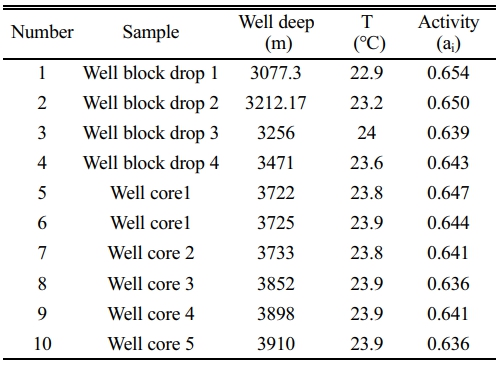







 Copyright 2019 International Orgranization for Ceramic Processing. All rights reserved.
Copyright 2019 International Orgranization for Ceramic Processing. All rights reserved.